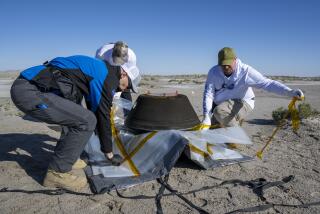SPACE WATCH : By Jupiter!
- Share via
Probably no natural event in modern times has quite so awed and humbled us as the spectacular fiery assault of the Shoemaker-Levy 9 comet on Jupiter. From a distance of 500 million miles came dazzling images of the impact of the comet’s 20 fragments. It is daunting to think that one of them left a black scar on the Jovian surface larger than the entire planet Earth.
Even veteran astronomers were thunderstruck at the size and power of the event, saying that their understanding of planetary physics would have to be revamped. The impact has generated a bonanza of new data from the Hubble Space Telescope that will keep scientists busy for years, and further images from the Galileo spacecraft are due in a few weeks.
The general public has been stirred too. Seldom does the public get a chance to witness science so dramatically, or to participate in the spirit of excitement, adventure and intellectual curiosity that drives scientific discovery.
Even Congress looked up from such dreary earthly concerns as Whitewater to direct NASA to search for similar asteroids and comets that could threaten our planet. And there was renewed interest in the theory--still unconfirmed--that it was the crash of an asteroid in Mexico 65 million years ago that led to the extinction of dinosaurs.
Writing in the journal Nature, Clark R. Chapman of the Planetary Science Institute in Tucson put it well: “The black patches on Jupiter have converted planetary impact processes from the realm of theoretical possibilities and ancient geological history to a manifest, dynamic reality.”






